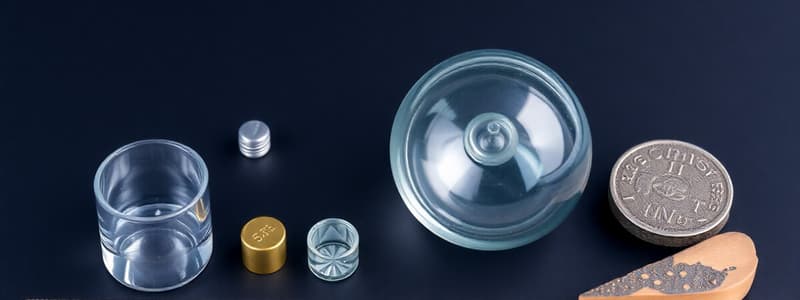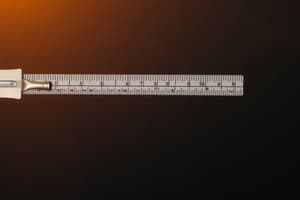Podcast
Questions and Answers
What is a physical quantity composed of?
What is a physical quantity composed of?
- Constant + variable
- Numerical value × unit (correct)
- Physical dimension × time
- Numerical value + constant
Which of the following is a standard characteristic of a unit of measurement?
Which of the following is a standard characteristic of a unit of measurement?
- It can be easily reproduced (correct)
- It can change over time
- It is extremely large
- It is ambiguous and uncertain
Which unit is the SI unit for measuring length?
Which unit is the SI unit for measuring length?
- Centimeter
- Millimeter
- Kilometer
- Meter (correct)
What is the role of standard units in measurement?
What is the role of standard units in measurement?
Which of the following is not a rule for writing units?
Which of the following is not a rule for writing units?
What is the metric equivalent of 1 kilometer?
What is the metric equivalent of 1 kilometer?
Which instrument is commonly used to measure small lengths?
Which instrument is commonly used to measure small lengths?
What is the purpose of defining a 'metre' in relation to a platinum-iridium bar?
What is the purpose of defining a 'metre' in relation to a platinum-iridium bar?
What is the primary device used to measure time accurately?
What is the primary device used to measure time accurately?
Which temperature scale is considered a theoretical scale?
Which temperature scale is considered a theoretical scale?
What is the normal body temperature in degrees Celsius?
What is the normal body temperature in degrees Celsius?
How do you convert Celsius to Fahrenheit using the provided formula?
How do you convert Celsius to Fahrenheit using the provided formula?
What type of thermometer is specifically designed to measure body temperature?
What type of thermometer is specifically designed to measure body temperature?
What is the SI unit of temperature?
What is the SI unit of temperature?
What happens to mercury in a laboratory thermometer when it is placed in hot water?
What happens to mercury in a laboratory thermometer when it is placed in hot water?
Which of the following does NOT represent a characteristic of a correct beam balance?
Which of the following does NOT represent a characteristic of a correct beam balance?
Which option describes approximation in measurement?
Which option describes approximation in measurement?
What is the purpose of the Department of Weights and Measures in India?
What is the purpose of the Department of Weights and Measures in India?
What is the correct method to avoid parallax error when measuring length with a metre scale?
What is the correct method to avoid parallax error when measuring length with a metre scale?
How should you measure the diameter of a spherical object according to the outlined method?
How should you measure the diameter of a spherical object according to the outlined method?
What is the primary purpose of winding a wire around a pencil in the measurement process?
What is the primary purpose of winding a wire around a pencil in the measurement process?
What is the SI unit of mass?
What is the SI unit of mass?
How is the surface area of a regular shape calculated?
How is the surface area of a regular shape calculated?
What distinguishes a beam balance as true?
What distinguishes a beam balance as true?
What is the main difference between mass and weight?
What is the main difference between mass and weight?
What precautions should be taken when using an electronic balance?
What precautions should be taken when using an electronic balance?
How is the thickness of a single rupee coin determined using multiple coins?
How is the thickness of a single rupee coin determined using multiple coins?
What is the primary function of a weight box?
What is the primary function of a weight box?
What is the method used to measure the length of a curved line?
What is the method used to measure the length of a curved line?
What does 1 inch convert to in centimeters?
What does 1 inch convert to in centimeters?
What is the standard error that can occur when using a metre scale for measuring?
What is the standard error that can occur when using a metre scale for measuring?
What is the main advantage of using an electronic balance over a traditional balance?
What is the main advantage of using an electronic balance over a traditional balance?
Flashcards are hidden until you start studying
Study Notes
Measurement and Physical Quantities
- Measurement compares an unknown quantity with a known constant or unit.
- Every measurement consists of a numerical value and a unit.
- A physical quantity can be defined as: Physical quantity = Numerical value × unit.
- Standard units ensure uniformity and reliability in measurements, avoiding discrepancies due to human body variations.
Need for Standard Units
- Prior to standard units, measurements were inconsistent.
- Standard units are defined by characteristics that include being of moderate size, unaffected by space and time, unambiguous, non-perishable, and easily reproducible.
Rules for Writing Units
- Unit names are written in lower case, except Celsius and Fahrenheit.
- Symbols for units named after scientists are in upper case, while other symbols remain in lower case.
- Units should not be followed by a full stop and written in plural form only when in words.
Measurement of Length
- Length is the distance between two points; the SI unit is the metre (m).
- A metre is based on a platinum-iridium bar kept in Paris.
- Tools for measuring length include rulers, measuring tapes, vernier calipers, and screw gauges.
- Common units include multiples (kilometre, hectometre) and submultiples (decimetre, centimetre, millimetre).
- Light-year measures astronomical distances, and microscopic measurements use microns and angstroms.
Measuring Techniques
- Accurate measurement requires proper placement and alignment to avoid parallax error.
- For spherical objects, measure diameter using solid blocks and a metre scale.
- Curved lengths can be measured using a thread, while the thickness of small objects can be determined by stacking.
Measurement of Area
- Area represents the surface enclosed by a boundary, measured in square metres (m²).
- Regular and irregular areas are assessed differently, with formulas and graph paper used respectively.
Mass and Weight
- Mass indicates the amount of matter in an object, while weight represents gravitational force acting on it.
- SI unit of mass is kilogram (kg); subunits include gram and milligram.
- Balance scales (grocer’s, beam, physical, electronic) are used to measure mass accurately.
Measurement of Time
- Time represents the interval between events; the SI unit is the second (s).
- Historical methods included sundials; modern timekeeping uses atomic clocks.
- Devices include clocks, watches, and stopwatches for various measurements.
Measurement of Temperature
- Temperature indicates the degree of hotness or coldness, measured with thermometers.
- SI unit is Kelvin; common scales are Celsius and Fahrenheit.
- Laboratory thermometers measure up to -100°C to 110°C, while clinical thermometers measure human body temperature.
Approximation in Measurement
- Approximation provides a quick but not exact measurement; accuracy reflects closeness to the true value.
- Errors can be mitigated by averaging multiple observations.
Standard Weights and Measures
- The Department of Weights and Measures in India ensures correctness of weights and measuring devices.
- Characteristics of accurate measuring devices include verification stamps and correct functionalities.
Studying That Suits You
Use AI to generate personalized quizzes and flashcards to suit your learning preferences.




